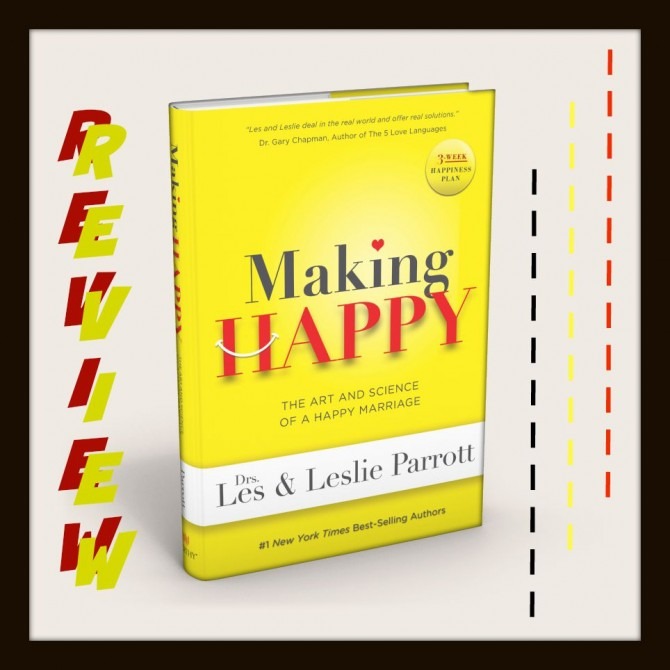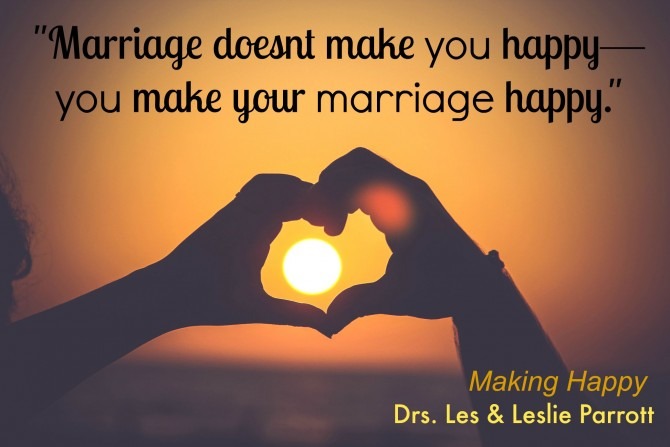The state of marriage in America is not a pretty picture: our nation sees one divorce every 36 seconds, with 41 percent of first-time marriages ending in divorce after an average of just eight years. Marriages that survive that critical first decade have a better prognosis (the median length of all first-time marriages is 45 years), but not every in-tact marriage is a good one. In fact, of all the people who get married, only three in ten remain in marriages that can be categorized as healthy and happy.
Gary Thomas, author of Sacred Marriage, is well-known for asking, “What if God designed marriage to make us holy instead of happy?” He certainly makes a valid point. But while happiness is not a requisite component of marriage—or even the most important one—it is indisputably a nice byproduct! Unfortunately, happiness doesn’t come naturally to every marriage, which is where Drs. Les and Leslie Parrot come in. This married team of relationship experts recognizes that “happy people are more loving people,” and their book Making Happy provides research-backed strategies and practical tips for increasing the happiness quotient—and, subsequently, the love quotient—of every marriage.
Happiness, as defined in Making Happy, is “the emotional state of feeling satisfaction, playfulness, contentedness, amusement, cheeriness, serenity, gratification, elation, triumph, joy, and/ or bliss.” This happiness falls into two categories: extrinsic and intrinsic. Extrinsic happiness is feelings-based and ephemeral, whereas intrinsic happiness is grounded in a spiritual source of satisfaction; unlike extrinsic happiness, values-based happiness is not ruled by the law of diminishing returns. Healthy happiness involves a balance of extrinsic and intrinsic happiness, and both types receive attention in Making Happy’s prescription for a happy marriage.
Before delving into the specifics of how to build a happy marriage, Making Happy explores the science and history of this desirable state. The study of happiness is not a new one, but in the past, people viewed one’s happiness as a matter of luck or divine intervention. It has only been in the last couple of centuries that we have begun to recognize happiness as a skill that can be developed.
In their efforts to determine how to develop this skill, happiness experts have discovered that happiness looks different for every individual. The biggest component of our happiness—50 percent—is determined by a combination of our biological heredity and early upbringing, and studies show that while we each experience a range of happiness, we generally return to the happiness levels that are set by around age 16. One’s circumstances have a comparatively small affect on happiness levels: external conditions determine just 10 percent of happiness. The remaining portion of our happiness is within our control, with 40 percent of happiness relying on our personal choices and habits. For those of us who desire to become happier, it is this 40 percent that requires our attention.
According to researcher Martin Seligman, the three ingredients for happiness are pleasure, engagement, and meaning. Drs. Les and Leslie Parrot call this “the hat trick of happiness,” and each of their tips for happiness enhancement involves at least one of these components. So, what are these strategies for increasing a marriage’s level of happiness? Making Happy outlines the following six happiness boosters: Count Your Blessings, Try New Things, Dream a Dream, Celebrate Each Other, Attune Your Spirits, and Add Value to Others.
Making Happy dedicates one chapter to each of the six happiness boosters. The authors utilize a combination of personal anecdotes and scientific research to highlight each strategy’s effectiveness, and they provide thoughtful instruction for how to implement each happiness booster in the context of marriage. Scattered throughout these chapters (and the rest of the book) are inspiring quotes, personal quizzes, and lists of questions to encourage discussion and reflection. Making Happy concludes with a detailed 21-Day Happiness Plan to help couples immediately begin to put these happiness boosters into action.
Making Happy is a fascinating read, but more importantly, it has been an excellent resource for enhancing my own marriage. This December, Luke and I will be celebrating our seventh wedding anniversary, and though we’ve faced our share of difficulties, our marriage thus far has been a happy one, and I’d like to keep it that way! However, as Making Happy has illustrated, that happiness won’t happen without some concentrated effort. Luke and I are looking forward to applying the Parrotts’ strategies to make our next SEVENTY years together as happy as they can be!
My Book Rating: 4.5 out of 5 stars.



[…] Making Happy, by Les and Leslie Parrott: This book from Christian relationship experts Les and Leslie Parott is filled with fascinating research and excellent tips on developing a happier marriage. I appreciated the science as well as the book’s faith component, and I loved that the authors moved beyond theory to suggest some easily applicable strategies that couples can use to enhance their marriage. I would like to reread this book with Luke and hope he will join me in working our way through the book’s 21-day Happiness Plan. (Original Review) […]